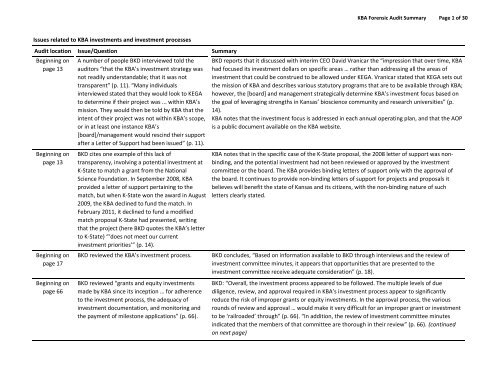Complete 2012 forensic audit documents - Kansas Bioscience ...
Complete 2012 forensic audit documents - Kansas Bioscience ...
Complete 2012 forensic audit documents - Kansas Bioscience ...
Create successful ePaper yourself
Turn your PDF publications into a flip-book with our unique Google optimized e-Paper software.
KBA Forensic Audit Summary Page 1 of 30<br />
Issues related to KBA investments and investment processes<br />
Audit location Issue/Question Summary<br />
Beginning on<br />
page 13<br />
Beginning on<br />
page 13<br />
Beginning on<br />
page 17<br />
Beginning on<br />
page 66<br />
A number of people BKD interviewed told the<br />
<strong>audit</strong>ors “that the KBA’s investment strategy was<br />
not readily understandable; that it was not<br />
transparent” (p. 11). “Many individuals<br />
interviewed stated that they would look to KEGA<br />
to determine if their project was ... within KBA’s<br />
mission. They would then be told by KBA that the<br />
intent of their project was not within KBA’s scope,<br />
or in at least one instance KBA’s<br />
[board]/management would rescind their support<br />
after a Letter of Support had been issued” (p. 11).<br />
BKD cites one example of this lack of<br />
transparency, involving a potential investment at<br />
K‐State to match a grant from the National<br />
Science Foundation. In September 2008, KBA<br />
provided a letter of support pertaining to the<br />
match, but when K‐State won the award in August<br />
2009, the KBA declined to fund the match. In<br />
February 2011, it declined to fund a modified<br />
match proposal K‐State had presented, writing<br />
that the project (here BKD quotes the KBA’s letter<br />
to K‐State) “‘does not meet our current<br />
investment priorities’” (p. 14).<br />
BKD reviewed the KBA’s investment process.<br />
BKD reviewed “grants and equity investments<br />
made by KBA since its inception … for adherence<br />
to the investment process, the adequacy of<br />
investment documentation, and monitoring and<br />
the payment of milestone applications” (p. 66).<br />
BKD reports that it discussed with interim CEO David Vranicar the “impression that over time, KBA<br />
had focused its investment dollars on specific areas … rather than addressing all the areas of<br />
investment that could be construed to be allowed under KEGA. Vranicar stated that KEGA sets out<br />
the mission of KBA and describes various statutory programs that are to be available through KBA;<br />
however, the [board] and management strategically determine KBA’s investment focus based on<br />
the goal of leveraging strengths in <strong>Kansas</strong>’ bioscience community and research universities” (p.<br />
14).<br />
KBA notes that the investment focus is addressed in each annual operating plan, and that the AOP<br />
is a public document available on the KBA website.<br />
KBA notes that in the specific case of the K‐State proposal, the 2008 letter of support was nonbinding,<br />
and the potential investment had not been reviewed or approved by the investment<br />
committee or the board. The KBA provides binding letters of support only with the approval of<br />
the board. It continues to provide non‐binding letters of support for projects and proposals it<br />
believes will benefit the state of <strong>Kansas</strong> and its citizens, with the non‐binding nature of such<br />
letters clearly stated.<br />
BKD concludes, “Based on information available to BKD through interviews and the review of<br />
investment committee minutes, it appears that opportunities that are presented to the<br />
investment committee receive adequate consideration” (p. 18).<br />
BKD: “Overall, the investment process appeared to be followed. The multiple levels of due<br />
diligence, review, and approval required in KBA’s investment process appear to significantly<br />
reduce the risk of improper grants or equity investments. In the approval process, the various<br />
rounds of review and approval … would make it very difficult for an improper grant or investment<br />
to be ‘railroaded’ through” (p. 66). “In addition, the review of investment committee minutes<br />
indicated that the members of that committee are thorough in their review” (p. 66). (continued<br />
on next page)


